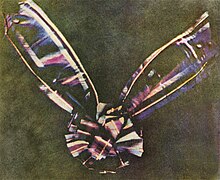Timeline of photography technology: Difference between revisions
Appearance
Content deleted Content added
rvv |
No edit summary |
||
| Line 87: | Line 87: | ||
[[ru:Хронология фотографии]] |
[[ru:Хронология фотографии]] |
||
[[sr:Хронологија фотографије]] |
[[sr:Хронологија фотографије]] |
||
i love cameras!!!!!<3 |
|||
Revision as of 15:50, 16 February 2009
Timeline of photography technology





- 1826 - Nicéphore Niépce takes the first permanent photograph, a landscape that required an eight hour exposure.
- 1835 - William Fox Talbot creates his own photography process.
- 1839 - Louis Daguerre patents the daguerreotype.
- 1839 - William Fox Talbot invented the positive / negative process widely used in modern photography. He refers to this as photogenic drawing.
- 1839 - John Herschel demonstrates hyposulfite of soda (also known as hypo, or sodium thiosulfate) as a fixer, and makes the first glass negative.
- 1851 - Introduction of the collodion process by Frederick Scott Archer.
- 1854 André-Adolphe-Eugène Disdéri credited with introduction of the carte de visite (French "visiting card"). Disdéri introduced a rotating camera which could reproduce eight individually exposed images on a single negative. After printing on albumen paper, the images were cut apart and glued to calling card-sized mounts. These tiny portraits were left by visiting friends, which inspired the name carte de visite.
- 1861 - The first color photograph, an additive projected image of a tartan ribbon, is shown by James Clerk Maxwell.
- 1868 - Louis Ducos du Hauron patents a method of subtractive color photography.
- 1871 - The gelatin emulsion is invented by Richard Maddox.
- 1876 - F. Hurter & V. C. Driffield begin systematic evaluation of sensitivity characteristics of photographic emulsions - science of sensitometry.
- 1878 - Eadweard Muybridge made a high-speed photographic demonstration of a moving horse, airborne during a trot, using a trip-wire system.
- 1887 - Celluloid film base introduced.
- 1888 - Kodak n°1 box camera is mass marketed; first easy-to-use camera.
- 1887 - Gabriel Lippmann invents a "method of reproducing colours photographically based on the phenomenon of interference".
- 1891 - Thomas Edison patents the "kinetoscopic camera" (motion pictures).
- 1895 - Auguste and Louis Lumière - Invented the cinématographe.
- 1898 - Kodak introduced their Folding Pocket Kodak.
- 1900 - Kodak introduced their first Brownie.
- 1901 - Kodak introduced the 120 film.
- 1902 - Arthur Korn devises practical phototelegraphy technology (reduction of photographic images to signals that can be transmitted by wire to other locations); Wire-Photos in wide use in Europe by 1910, and transmitted intercontinentally by 1922.
- 1907 - The Autochrome Lumière is the first color photography process marketed.
- 1912 - Vest Pocket Kodak using 127 film.
- 1913 - Kinemacolor, the first commercial "natural color" system for movies is invented.
- 1914 - Kodak introduced the Autographic film system.
- 1920s - Yasujiro Niwa invented a device for phototelegraphic transmission through cable and later via radio.
- 1923 - Doc Harold Edgerton invents the xenon flash lamp and strobe photography.
- 1925 - The Leica introduced the 35mm format to still photography.
- 1932 - The first full-color Technicolor movie, Flowers and Trees, is made by Disney.
- 1934 - The 135 film cartridge was introduced, making 35mm easy to use.
- 1936 - Introduction by IHAGEE of the Ihagee Kine Exakta 1, the first 35mm. Single Lens reflex camera.
- 1936 - Development of Kodachrome multi-layered reversal color film.
- 1937 - Agfacolor-Neu reversal color film.
- 1939 - Agfacolor negative-positive color material, the first modern "print" film.
- 1939 - The View-Master stereo viewer is introduced.
- 1942 - Kodacolor, Kodak's first "print" film.
- 1947 - Dennis Gabor invents holography.
- 1948 - The Hasselblad camera was introduced.
- 1948 - Edwin H. Land introduces the first Polaroid instant image camera.
- 1952 - The 3-D film craze begins.
- 1954 - Leica M Introduced

- 1957 - First Asahi Pentax SLR introduced.
- 1957 - First digital image produced on a computer by Russell Kirsch at U.S. National Bureau of Standards (now known as the National Institute of Standards and Technology, or NIST). [1]
- 1959 - Nikon F introduced.
- 1959 - AGFA introduces the first fully automatic camera, the Optima.
- 1961 - Eugene F. Lally of the Jet Propulsion Laboratory published the first description of how to produce still photos in a digital domain using a mosaic photosensor.[1]
- 1963 - Kodak introduces the Instamatic.
- 1964 - First Pentax Spotmatic SLR introduced.
- 1973 - Fairchild Semiconductor releases the first large image forming CCD chip; 100 rows and 100 columns.
- 1975 - Bryce Bayer of Kodak develops the Bayer filter mosaic pattern for CCD color image sensors.
- 1986 - Kodak scientists invent the world's first megapixel sensor.
- 2005 - AgfaPhoto files for bankruptcy. Production of Agfa brand consumer films ends.
- 2006 - Dalsa produces 111 megapixel CCD sensor, the highest resolution at its time. [2]
- 2006 - Polaroid announces it is discontinuing the production of all instant film products, citing the rise of digital imaging technology. [3]
See also
References
- ^ Eugene F. Lally, "Mosaic Guidance for Interplanetary Travel," Space Flight Report to the Nation, pp. 2249–61, American Rocket Society, New York, October 9–15, 1961.
External links
- More about the earliest photograph
- In the eye of the camera — Illustrated historical essay about early photography
- Lippmann's and Gabor's Revolutionary Approach to Imaging
i love cameras!!!!!<3
